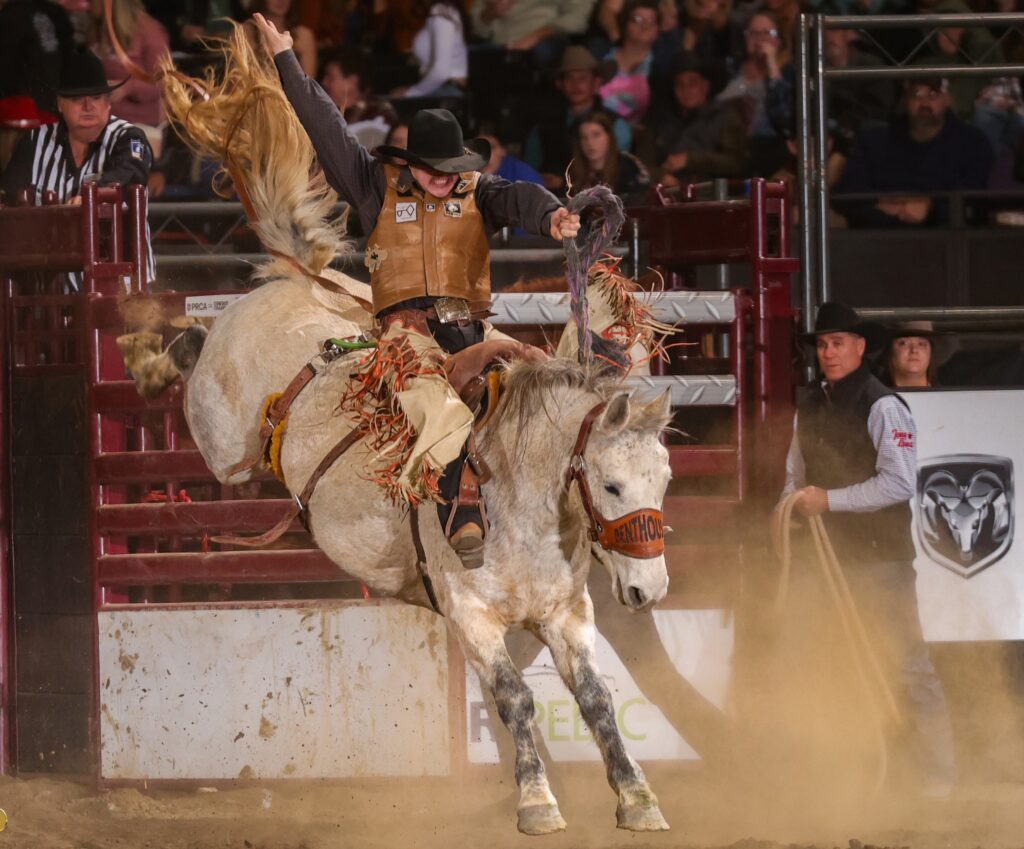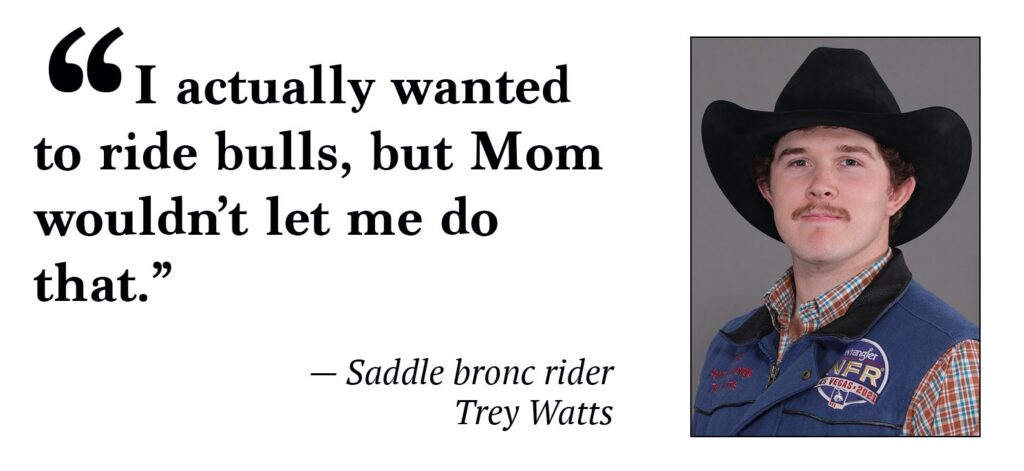‘I never would have thought I would make it here’: Palmyra saddle bronc rider captures PRCA title

PALMYRA, Mo. — Trey Watts was a little unsure about his decision when he first began saddle bronc riding as a high school freshman in Muncy, Pa.
“I didn’t know if I was going to make it,” he admitted. “I was bucked off a lot when I first started. There were a lot of ungraceful landings. I never would have thought I would make it here.”
Here is the Professional Rodeo Cowboys Association (PRCA) Great Lakes Circuit season-culminating champion after Watts, now a Palmyra resident, won two of three rounds in the saddle bronc competition at the North American Championship Rodeo Nov. 9-11 in Louisville, Ky.
He captured the second round with an 81.5-point ride on Bonafide, the highest saddle bronc ride of the event, and then tied for the top spot in the third round with an 81-point ride on Back Page.
That, combined with his 78-point ride on Malibu Momma in the opening round, gave Watts a three-round score of 240.5 points, good enough to hold off Byron Gilliland by seven points to win $8,298 on top of his $17,835 in earnings during the season.
“I think I finished pretty good, but I didn’t start well in the first round,” Watts said. “In the second round, Bonafide is a scary horse to get on. I had been on her once before and she made me look silly. But they say if you start her good, she’s pretty rider friendly, and we had a good start.
“I had a conservative ride in the third round. I had a nice horse, and I watched a couple of other guys high in average have some tough luck. I knew I had to have a good bronc ride to win the average.”
It was an early birthday present for Watts, who turns 25 on Nov. 29. While he has previously won the season-long Great Lakes Circuit championship, he was runner-up twice in the culminating rodeo competition.
“It was really important,” said Watts, who met Sheyenne Anderson of Palmyra while they were attending Missouri Valley College in Marshall and moved to her hometown after graduating. “Maybe it will help me get into some of the bigger rodeos.”
Because of his parents’ involvement, Watts has been around rodeos since he was 4 or 5 years old. He started out as a roper but being naturally left-handed proved to be a detriment. He tried roping calves right-handed as he got older, but admits he was “not good at it,” so he turned to saddle bronc riding.
“I actually wanted to ride bulls, but Mom wouldn’t let me do that,” he said.
He attended several bronc riding schools and then competed in high school and amateur events. He got his PRCA card when he was 18 and continued to compete in amateur and collegiate events, as well as professional rodeos.
“It’s not like basketball where there is a gym in every town you can go practice,” Watts said. “Bronc riding schools are the best way to start. They have good horses for kids to get on when they’re getting started.”

In bronc riding, a competitor climbs onto a horse, which is held in a small pipe or wooden enclosure called a bucking chute. When the rider is ready, the gate is opened and the horse bursts out and begins to buck.
The rider attempts to stay on the horse for eight seconds without touching the horse with their free hand. Both the horse and rider are scored on a scale of 0 to 50, and the ride is rated as the sum of those individual scores.
Scores in the 80s are considered very good, and those in the 90s are exceptional. A horse that bucks in a spectacular and effective manner will score more points than a horse that bucks in a straight line with no significant change in direction.
In saddle bronc, the rider uses a specialized saddle with free-swinging stirrups and no horn. The rider grips a rein braided from cotton or polyester that is attached to the leather halter worn by the horse.
On the first jump out of the chute, the rider must “mark the horse out,” or have the heel of their boots above the shoulders before the horse’s front legs hit the ground.
“It gives the advantage to the horse and exposes you to getting bucked off,” Watts said of the mark-out rule. “It’s pretty tough if a horse ducks and dives left and right. If a horse throws his head back at you, it changes the length of the rein, and that can be tough.”
The PRCA is divided into 12 geographical circuits. The Great Lakes is comprised of events in Missouri, Illinois, Indiana, Michigan, Wisconsin and Minnesota. The top 12 money winners in each circuit advance to the finals, something Watts has accomplished four times.
Most season-long events are one-day, one-ride rounds. Watts finished first eight times in more than 50 events he entered during the 2023 season.
Many rodeos are part of county fairs or festivals. Riders often hop-scotch from one to another, riding one horse — and hopefully cashing in some winnings — before moving on to the next.
For instance, Watts competed in three separate Wisconsin rodeos over three days in mid-August, a schedule he repeated several times over the spring and summer.
“It’s always good to have a couple of buddies who will tag along and a car that gets good gas mileage,” said Watts, who works for Pro Med Animal Health in Palmyra.
The payday at the North American Championship Rodeo was Watts’ largest on the PRCA. He said he won “$11,000 or $12,000” at an International Professional Rodeo Association event two years ago, and about the same amount at a rodeo in Canada.
By comparison, Sage Newman of Montana was the money leader in saddle bronc riding competitions in 2022 with $253,000 in total earnings.
“Those guys are going all over the country and into Canada,” Watts said. “They’re gone months at a time. I thought I might try that, but I had a kid last spring, and I don’t think I could stand being away that long.”
Plus, Watts knows his days as a bronc rider are likely numbered.
“There’s not a lot of bronc riders past the age of 30,” he said. “I’m getting close to my prime. I’ve already been riding for seven, eight years and I know I’m getting closer to my body not letting me do it anymore.
“My back hurts a lot. I’ve had some groin trouble. My ankle isn’t the same since I broke it last year. I feel like I’m getting crippled all over. I love it, though. I’m going to have to find something to do when I quit riding broncs to still be part of rodeo.”
That shouldn’t be hard.
Sheyenne Anderson also has a history of competing in rodeo events from an early age. She finished second in the nation in goat tying competition at the College National Rodeo in Casper, Wyo., as a senior at Missouri Valley. She also competed in barrel racing and breakaway roping, among other events.
The family tradition will likely continue with their 7-month-old son, Walker.
“As soon as he starts walking, we’ll get him going,” Watts said. “Mom wants him to be a roper, but I think he’ll be a bronc rider, too.”
Miss Clipping Out Stories to Save for Later?
Click the Purchase Story button below to order a print of this story. We will print it for you on matte photo paper to keep forever.
